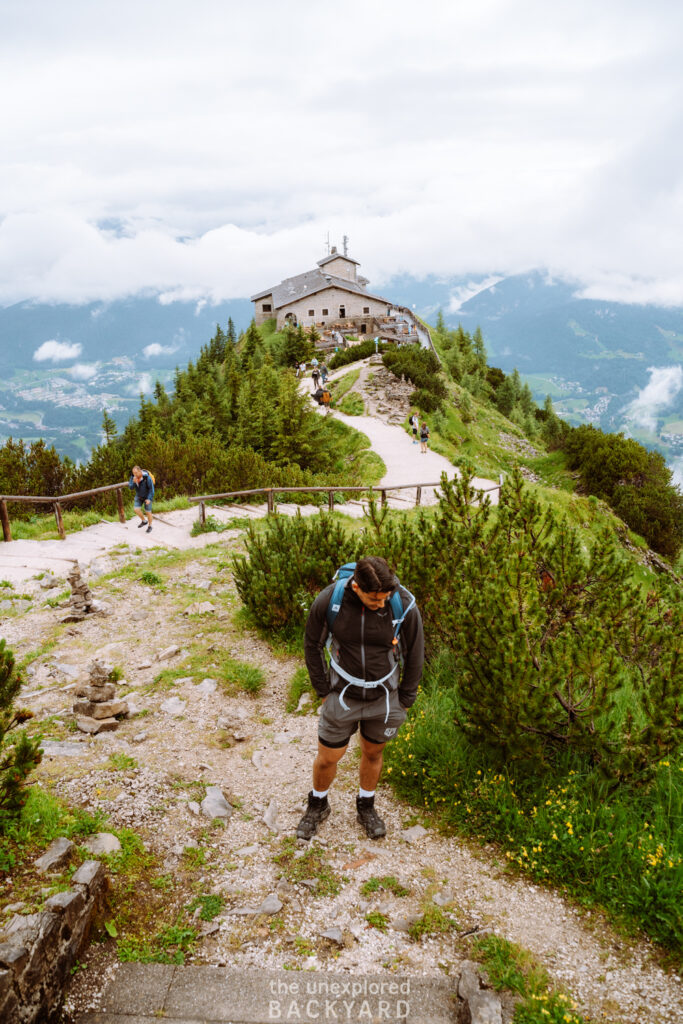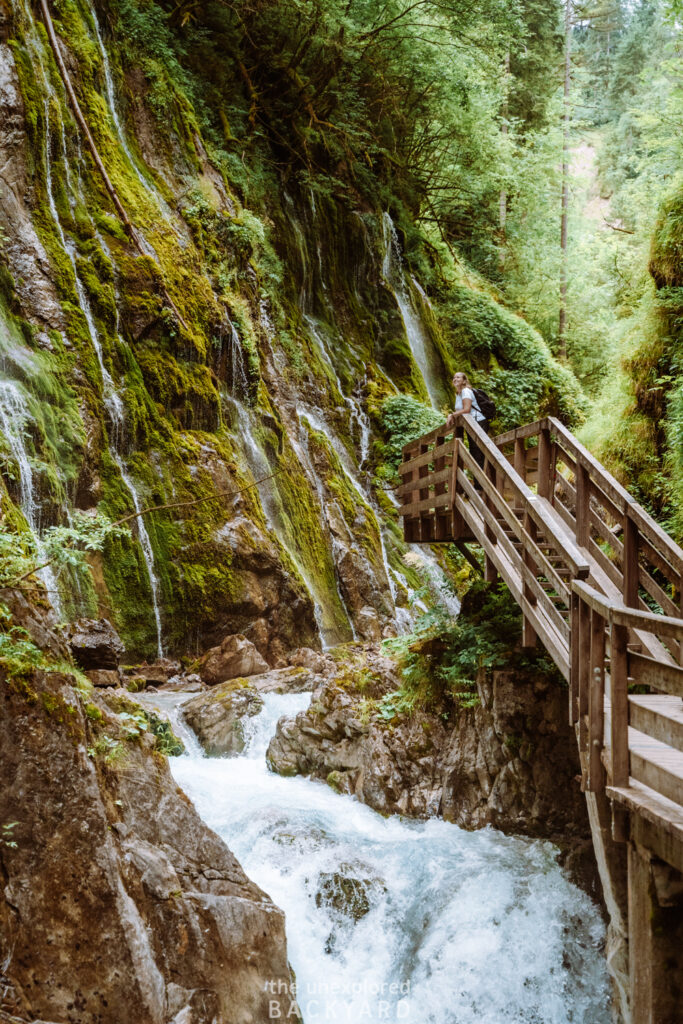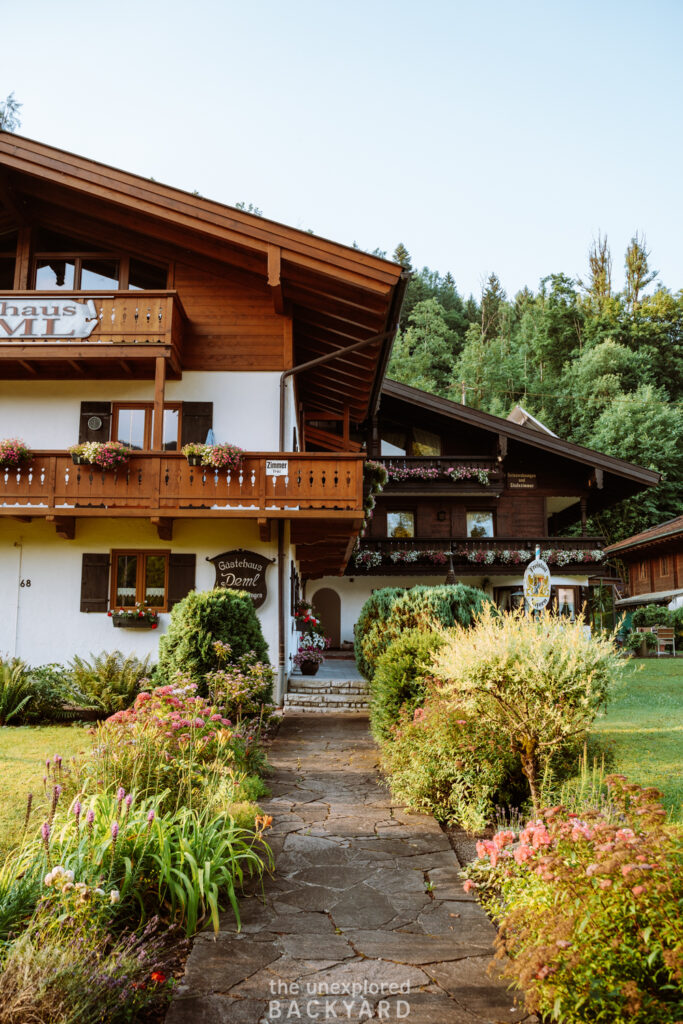This post may contain affiliate links. By purchasing through my links you can help support me at no additional cost to you, thank you!
When planning a trip to Bavaria, visiting Eagle’s Nest (locally known as Kehlsteinhaus) is a must. Here is everything you need to know!
If you’re an adventure enthusiast or a history buff, the Eagle’s Nest (locally known as Kehlsteinhaus) is an absolute must-see on your travel itinerary. Nestled high in the Bavarian Alps, this iconic site promises not only stunning panoramic views but also a fascinating glimpse into World War II history. As you embark on your journey to the Eagle’s Nest, get ready to be enthralled by the breathtaking landscapes and the rich historical context that surrounds this unique landmark.
In this post, I’ll guide you through everything you need to know about visiting the Eagle’s Nest in Germany. From detailed travel directions and tips on the best time to visit, to essential insights into the historical significance of the site, I’ve got you covered.
Discover how to navigate the scenic route to this mountain-top retreat, what to expect once you arrive, and why the Eagle’s Nest is worth every bit of the trip. For those eager to delve deeper into history, learn about the connection between the Eagle’s Nest and Adolf Hitler. In addition, I’ll briefly mention how this alpine retreat was used during the Third Reich. Lastly, for a seamless travel experience, I’ll include recommendations for nearby accommodations and additional points of interest in the Berchtesgaden region.
Whether you’re drawn by the historical intrigue or the allure of the majestic Bavarian Alps, I hope this post inspires you to add the Eagle’s Nest to your Germany itinerary. Get ready to explore one of the most remarkable and historically rich destinations in the world!
Table of Contents
ToggleFAQs about Eagle’s Nest
How to visit Eagle’s Nest Germany?
To visit Eagle’s Nest in Germany, start by traveling to Berchtesgaden, which is accessible from Salzburg, Austria, or Munich, Germany. From Berchtesgaden, head to the Dokumentation Obersalzberg to purchase tickets for the bus that takes you up the Kehlstein mountain. After a scenic bus ride, you will take a historic elevator through the mountain to reach the Eagle’s Nest, where you can explore the site and enjoy stunning alpine views.
Is it worth seeing the Eagle’s Nest?
Visiting the Eagle’s Nest is definitely worth it due to its significant historical value. Additionally, the site offers breathtaking panoramic views of the Bavarian Alps, making it a must-see for nature lovers and photographers. The journey itself, including the bus ride and elevator ascent, adds to the memorable and educational experience.
How long is the bus ride up to Eagle’s Nest?
The bus ride up to the Eagle’s Nest, or Kehlsteinhaus, typically takes about 20 minutes. This scenic journey navigates a steep and narrow mountain road, offering passengers stunning views of the Bavarian Alps along the way.
This post is all about Eagle’s Nest (Kehlsteinhaus).
What is the Eagle’s Nest (Kehlsteinhaus)
How it got started:
It’s no secret that this special building has a very unique and pretty dark history. While I urge each and every one of you to do your own research, below you can find a quick rundown of the main events and what you need to know! The Eagle’s Nest, locally known as Kehlsteinhaus, is a historic alpine retreat perched atop the Kehlstein mountain in Bavaria, Germany. Constructed in 1938, it was commissioned by Martin Bormann as a 50th birthday gift for Adolf Hitler. It was designed to serve as a teahouse and a retreat for Nazi officials. The building exemplifies the architectural ambition and the strategic importance placed on the Obersalzberg region during the Third Reich. Remarkably, the construction was completed in just over a year, despite the challenging mountainous terrain.
Hitler, however, used the Eagle’s Nest infrequently, reportedly visiting the site around 14 times due to his fear of heights and aversion to the thin mountain air. So while the Kehlsteinhaus is known as Hitler’s retreat, he was one of the people who visited it the least!
During its brief operational period, the Eagle’s Nest served as a venue for official meetings and a place to impress dignitaries with its stunning panoramic views of the Bavarian Alps. However, it was spared from the destruction that befell many other Nazi sites at the end of World War II. After the war, the building was handed over to the Bavarian state and transformed into a public historical site.
What it is today:
Today, the Eagle’s Nest functions as a museum and a popular tourist destination, drawing visitors keen to explore its historical significance and enjoy the breathtaking scenery. The site is accessible via a scenic bus ride followed by an elevator ascent through the mountain, offering a unique and memorable experience. While much of the original decor has been removed, the building retains its historical aura, serving as a poignant reminder of its dark past and a testament to the complex history of the region.
Where is the Eagle’s Nest (Kehlsteinhaus)
Hitler’s Eagle’s Nest, known as Kehlsteinhaus in German, is located in the Bavarian Alps in southeastern Germany. Specifically, it is situated near the town of Berchtesgaden, on the Kehlstein mountain. The site is part of the larger Obersalzberg complex, which included other residences and bunkers used by Nazi officials during the Third Reich. The exact address is Kehlsteinhaus, Kehlsteinstraße, 83471 Berchtesgaden, Germany.
How to visit the Eagle’s Nest
In total, there are three different ways through which you can visit the famous Kehlsteinhaus, and I will outline them all below so that you can pick the one that suits you the best.
By Bus:
If you wish to visit the Eagle’s Nest the “self-guided” way, then you will have to take a special bus up to the retreat. The road leading up the house is quite special in that it rises over 800m in altitude. In addition, it is a private road and they have decided to only allow their busses to drive up. At the end of the day, this helps ensure safety for all visitors, as the road can be dangerous at times.
To reach the Eagle’s Nest by car you want to navigate to the “Parkplatz Obersalzberg – Dokumentationszentrum“. The parking here is considerably cheap compared to other parking lots in the area as it will cost you 5€ for a day ticket. Then, make your way over to the bus departure point here. The admission ticket can be found here, and the line can get long so make sure to arrive well before your desired departure time.
The first bus of the day departs at 8:30 while the last bus departs at 16:15. The buses go up every 25 minutes, so if you miss a departure then you won’t have to wait long until the next one. Additionally, the journey takes around 15-20 minutes. When you buy the ticket going up, then you will also immediately get a bus time for the way down, unless you buy a one-way ticket. Typically they will provide you with a bus going down two hours later. Please note that the last bus going down leaves at 16:50. If you buy a one-way ticket then you can stay as long as you’d like and then simply hike back down. You can find an up-to-date bus schedule here.
Prices:
The prices for the bus vary depending on age and whether you want a one-way or return ticket. If you have a guest ticket for the region, then the return ticket for adults will cost just under 30€ while a regular return trip costs just under 32€. The ticket for a one-way trip is around 25€. If you’re short on time I recommend getting a return ticket since the price difference isn’t that big. For kids between 6-14 years old expect half the price per ticket. You can find the price breakdown on this website.
By Hike:
The Eagle’s Nest is technically free to visit, although you need to buy some pretty expensive bus tickets to go up here. Therefore, if you’d like to check it out but want to avoid the bus fees, then you can also hike up instead. The hike itself is not very long as it’s only 4.5 kilometers each way. However, it has an elevation gain of just over 800 meters meaning it can be quite strenuous at times. You should expect the hike to take anywhere between 2-3 hours. While the hike is not spectacularly pretty, as you mainly walk through a forest the whole way, it does provide a calm and rewarding alternative to reaching the Kehlsteinhaus.
To start the hike, simply park at the same parking lot as you would for the bus shuttle and locate the sign for the hiking trail. Note that on the sign it says it will take 4 hours to reach the top, but that is rarely the case. If you would like to get up to the retreat early to avoid the crowds but also experience the hiking trail, then consider buying a one-way ticket. This way you can hike down at your own pace through the picturesque forest.
By Tour:
If you’re not planning to visit the Berchtesgaden National Park, but are instead visiting either Munich or Salzburg then you can still visit this fascinating historical site. There are lots of day trips to choose from departing from either city. These tours will already include the bus shuttle fees and ensure to plan everything regarding the visit for you, making it super easy and hassle-free. This is a great way to combine a trip to explore both important historical sites, and see some of the breathtaking nature found in the Bavarian Alps!
When to visit Eagle’s Nest (Kehlsteinhaus)
Time of year:
The road leading up to the Eagle’s Nest is closed during the winter months due to heavy snowfall and icy conditions, making it unsafe for travel. The steep and narrow mountain road becomes particularly hazardous. This is why the site is inaccessible from November through mid-May.
Due to this, the best (and only 😅) time to visit the Eagle’s Nest is from mid-May to October when the site is open to the public. Specifically, the Eagle’s Nest typically opens around May 15th and closes on October 31st. However, the exact dates can vary slightly each year based on weather conditions. During these months, the weather is generally favorable, allowing visitors to enjoy the panoramic views of the Bavarian Alps fully.
The peak summer months, from June to August, are particularly popular due to the warm weather and clear skies, which offer the best visibility for the stunning alpine views. However, if you prefer fewer crowds, consider visiting in May, September, or early October. The weather will still be pleasant, but the tourist numbers are definitely lower.
Time of day:
For the best experience, visiting the Eagle’s Nest early in the day is ideal. Arriving in the morning allows you to avoid the peak tourist rush and enjoy the tranquility and beauty of the site. Additionally, morning visits often provide clearer skies and better lighting for photography. This will enhance the overall experience of this historic and scenic destination.
I would recommend having a general overview of when you would like to visit but not reserving anything in advance. Since the weather here can be very unpredictable, you never know how the visibility will be in the mornings. It would be a shame to reserve the bus shuttle for a day when the weather is bad. Additionally, they don’t offer refunds for online bookings. If you come around 20-30 minutes before the first bus departs, you should have no problem getting a ticket!
With this said, you can still visit when the visibility isn’t great, and hope that it will clear up once you’re at the top. This happened to us as we planned to visit just before leaving the Berchtesdagen National Park region. Since we had no way of coming back, we decided to take the chance and took the bus when everything was foggy and covered in clouds. There wasn’t even 10 meters of visibility 😂. While I was quite upset when we were at the top, luckily it cleared up around 45 minutes before our bus went back down. So long story short, there is always a possibility that the weather will get better!
What to do at Eagle’s Nest (Kehlsteinhaus)
There isn’t much to do at the top of Eagle’s Nest once you arrive on the bus. However, with some extra preparation, you can ensure you get the most out of your visit!
If you are fascinated by history, especially that of the Third Reich, then definitely consider taking a guided tour. These tours will often get access to more rooms at the Eagle’s Nest beyond public access. Additionally, it’s a great way to get the full context of the site you are exploring. Many of these tours will also take you to Hitler’s headquarters compound and his former home. These tours typically last around 3.5-4 hours. You can find more information about them here.
If you think that the shuttle price is already steep, then don’t worry! There is a lot of information regarding the Eagle’s Nest on different displays around the house complex and even outside. In addition, by the parking lot, you can find the Documentation Center. This is a museum dedicated to remembering the horrible acts of the Third Reich. They are open daily from 9 until 17 with the last admission at 16. It only costs 3€ to visit for adults, and it is free for children under 18 years old. You can read more about visiting here.
While here, you should of course enjoy the stunning views over the Bavarian Alps. The vantage point offers a 360-degree panorama that includes the surrounding mountains and valleys. Lastly, you can enjoy a meal or a drink at the on-site restaurant, which offers traditional Bavarian cuisine and refreshments. The terrace provides an excellent spot to relax and take in the views.
Other Activities and Nearby Attractions
Königssee:
Königssee which means “Kings Lake” is one of the most beautiful lakes in all of Germany and is located close to Eagle’s Nest. After your visit, you can quickly drive down here and spend the afternoon exploring this beautiful lake and even go swimming! You can also find a small boat rental spot called “Bootshäuser am Königssee” and explore the lake. While there are also organized boat tours to explore the whole lake, I recommend spending a full day doing that.
Wimbachklamm:
Wimbachklamm is a stunning gorge located in the Berchtesgaden National Park region. The hike to Wimbachklamm is short and the gorge is only 200 meters long. Due to this, it only requires around 1 hour to see properly. It’s honestly such a beautiful gem and there are several waterfalls along the gorge making it a must-visit! If you are interested in checking it out, make sure to read my full guide below.
Read more: Wimbachklamm Bavaria
Salzburg:
Visiting Salzburg, located just 30 kilometers from the Eagle’s Nest, is a must for anyone exploring the Bavarian Alps region. This picturesque Austrian city is renowned for its baroque architecture, charming old town, and as the birthplace of Mozart. Here you can stroll through the historic center, a UNESCO World Heritage site, and visit iconic landmarks like Hohensalzburg Fortress and Mirabell Palace. Salzburg also offers a vibrant cultural scene, delightful cafes, and the stunning Salzach River, making it a perfect addition to your itinerary.
Where to stay when visiting Eagle’s Nest (Kehlsteinhaus)
When planning a trip to Eagle’s Nest and in general to Berchtesgaden National Park, then the best base would be Berchtesgaden. This town is the biggest and most well-known in this part of Bavaria. While it is still quite small, giving the perfect feeling of a small mountain village, Berchtesgaden is extremely well connected to popular attractions in the area. All busses typically depart from Berchtesgaden and you will also find a wider range of accommodation options here. Furthermore, if you are looking to stay at an Airbnb and cook your own food to save money, then you can find all of the major stores here.
Best mid-range hotel: Hotel AlpinaRos
Best luxury hotel: Hotel EDELWEISS Berchtesgaden Superior
If you decide to rent a car then you will have more flexibility when it comes to accommodation options. Overall, any town near Berchtesdagen will make for a great option since it will be close to Eagle’s Nest and other nearby attractions. However, even with a car I still think Berchtesgaden is the best and most convenient base for exploring the National Park. Also, it has a super charming city center making it an attraction in itself!
That concludes my guide to visiting the Eagle’s Nest, or as locals call it the Kehlsteinhaus. This fascinating piece of history is an absolute must when you are in the area. I hope that this guide has given you all the information you need for your visit! If you are still in doubt about some things, feel free to let me know below!




























Thank You for the information. Is it difficult to travel from Eagles Nest to Salzburg as an American tourist? Is anything required other than a passport? Are there public buses that transport from Berchtesgaden to Salzburg?
Hey Jessica! A passport should be enough since neither countries require a visa. You can find bus 838 which will take you from Eagle’s Nest to Berchtesgaden (a 12-minute bus ride), and from there take bus 840 directly to Salzburg (the journey lasts just over 40 minutes). Let me know if you have any other questions! 🙂